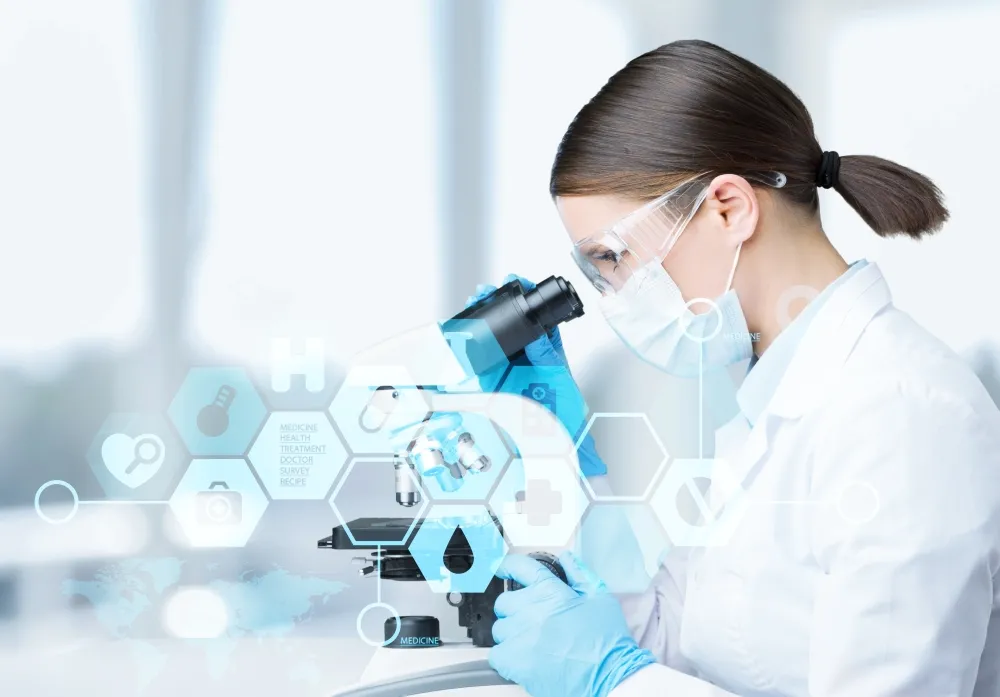Cell Culture-based Flu Vaccine Market 2025: A Breakthrough in Scalable, Safe Influenza Immunization
As healthcare systems increasingly focus on resilience, speed, and precision in immunization, the cell culture-based flu vaccine market is rapidly gaining momentum. Moving into 2025, this next-generation platform is transforming how flu vaccines are developed, manufactured, and distributed—offering a highly scalable and scientifically robust alternative to traditional egg-based methods.
In an era where vaccine agility and reliability are critical, cell culture-based flu vaccines represent a turning point for global influenza prevention strategies.
Traditional flu vaccines, long manufactured using embryonated chicken eggs, are effective but have inherent drawbacks. The process is time-consuming, can introduce strain-altering mutations, and excludes individuals with egg allergies. More critically, it lacks the flexibility to rapidly adapt to emerging flu variants during outbreaks or pandemics.
Cell culture-based vaccines overcome these challenges by growing influenza viruses in mammalian cell lines within a sterile bioreactor environment. This innovative approach not only speeds up production but also improves antigen fidelity, making the vaccine more accurate to circulating viral strains.
With the global burden of seasonal influenza affecting millions annually, and concerns over future pandemics still fresh, stakeholders across public health, biotech, and pharmaceutical industries are turning toward this resilient solution.
Market Drivers: Why Demand Is Accelerating
Several key forces are driving growth in the cell culture-based flu vaccine market in 2025:
- Speed and scalability: Cell culture systems can begin production immediately after strain selection, bypassing the six-month timeline associated with egg-based processes.
- Improved safety and tolerability: By eliminating egg proteins, cell-based vaccines reduce the risk of allergic reactions and allow for broader patient inclusion.
- Greater accuracy in strain matching: Cell-derived antigens are closer in structure to wild-type viruses, improving vaccine efficacy.
- Pandemic preparedness priorities: Governments are investing in next-gen vaccine infrastructure to ensure supply continuity during global health emergencies.
- Rising global flu incidence and high-risk populations: With more elderly, immunocompromised, and chronic illness patients, the need for safe, flexible vaccines is higher than ever.
- Public health agencies are also promoting wider vaccine coverage. As a result, manufacturers are racing to meet both seasonal and stockpile demands, making the cell culture platform increasingly attractive.
Innovation at the Core of Market Evolution
Innovation is the foundation of the market’s growth. Modern biotechnologies are reshaping how influenza vaccines are conceptualized, refined, and delivered.
- Advanced cell lines such as MDCK (Madin-Darby Canine Kidney) and Vero cells are being optimized for higher yields and greater consistency across batches.
- Bioprocessing automation is reducing contamination risks and operational costs, enabling more efficient vaccine manufacturing.
- AI-assisted strain prediction models are improving the speed and accuracy of annual vaccine updates, reducing the lag between surveillance and formulation.
- Next-gen adjuvants are enhancing immunogenicity, potentially lowering the required dose and increasing protection, especially in vulnerable populations.
- Manufacturers are also experimenting with combination vaccines, incorporating protection against multiple respiratory viruses—including influenza, RSV, and COVID-19—within a single cell culture-based shot. These advancements open doors to broader, year-round respiratory protection.
Regional Market Dynamics: A Global Adoption Landscape
Adoption of cell culture-based flu vaccines is progressing at different speeds across the globe, shaped by regulatory frameworks, infrastructure capacity, and local public health initiatives.
- North America
The U.S. is leading the charge, thanks to long-term investments in pandemic preparedness and a proactive regulatory stance. With strong support from agencies like BARDA and the CDC, several domestic manufacturers have scaled up production, making cell-based flu vaccines a core part of national immunization strategy. - Europe
In Europe, countries such as Germany, Italy, and the UK are embracing cell-based vaccines to reduce dependency on imported egg supplies and to strengthen domestic biomanufacturing capacity. The European Medicines Agency (EMA) has supported faster review cycles, helping new technologies reach market more quickly. - Asia-Pacific
In the Asia-Pacific region, rapid healthcare modernization in countries like Japan, China, and South Korea is accelerating demand for alternative vaccine platforms. National health agencies are allocating funding to update aging infrastructure, with a focus on self-sufficiency and resilience against future outbreaks. - Latin America & Middle East
While still emerging markets for cell culture-based flu vaccines, both Latin America and the Middle East are showing signs of interest, particularly through international partnerships and funding support. Local manufacturing hubs are being explored to reduce reliance on international supply chains during seasonal peaks.
Strategic Considerations for Stakeholders
To fully capitalize on opportunities in this evolving market, companies and governments must align on key strategic priorities:
- Expand local manufacturing capabilities to ensure faster distribution and reduce dependence on centralized facilities.
- Invest in public-private partnerships that accelerate technology transfer, R&D innovation, and global supply chain development.
- Enhance clinician and public education around the differences between cell-based and egg-based flu vaccines to build trust and uptake.
- Pursue flexible regulatory pathways to facilitate approval and deployment of new formulations, especially during public health emergencies.
- Support continuous innovation in formulation, delivery methods (e.g., nasal sprays, microneedle patches), and combination vaccine development.
Companies that take a proactive, long-term view—balancing innovation with scalability—are likely to become dominant players in the global influenza vaccine space.
Conclusion: Cell-Based Vaccines Are Setting the New Standard
As we approach 2025, the cell culture-based flu vaccine market is no longer an emerging trend—it is an essential response to the limitations of traditional vaccine platforms. Offering better precision, faster production, and broader patient applicability, these vaccines are aligning with the modern healthcare demand for speed, safety, and flexibility.
For healthcare market research clients, the time is right to monitor, invest in, and support the growth of this next-generation market. Whether tracking innovations, assessing partnerships, or forecasting regional demand, cell culture-based flu vaccines represent one of the most resilient and scalable solutions in the global fight against influenza.
NOTE:
Quants and Trends is proud to offer an extensive portfolio of meticulously researched healthcare market reports, numbering in the thousands. We also provide tailored customization services to ensure our insights align precisely with your strategic objectives and informational needs. For personalized assistance or to discuss your specific requirements, we invite you to get in touch with our team. We also encourage you to request a complimentary sample PDF report. Please visit our Sample Request Page to receive yours today.
Key Market Players
CSL
Segmentation By Type
Vial
Prefilled
Segmentation By Application
Public Sector
Private Sector
Segmentation By Region
North America (United States, Canada and Mexico)
Europe (Germany, France, United Kingdom, Russia, Italy, and Rest of Europe)
Asia-Pacific (China, Japan, Korea, India, Southeast Asia, and Australia)
South America (Brazil, Argentina, Colombia, and Rest of South America)
Middle East & Africa (Saudi Arabia, UAE, Egypt, South Africa, and Rest of Middle East & Africa)
Market SWOT Analysis
What are the strengths of the Cell Culture-based Flu Vaccine Market in 2025?
The primary strength lies in its enhanced production efficiency and speed compared to traditional egg-based methods, allowing for a faster response to emerging flu strains. Cell culture technology offers improved consistency and higher yield, leading to more reliable vaccine production. Additionally, the growing demand for seasonal flu vaccines globally supports the market's expansion.
What weaknesses could hinder the growth of the Cell Culture-based Flu Vaccine Market in 2025?
The high initial investment required to set up cell culture-based production facilities could be a challenge for smaller manufacturers. Moreover, regulatory hurdles and the complexity of scaling up production could slow down market adoption. There is also the risk of limited understanding and acceptance among some healthcare providers and patients.
What opportunities exist for the Cell Culture-based Flu Vaccine Market in 2025?
There is significant opportunity for market growth due to increasing global awareness of the importance of flu vaccination. Furthermore, advancements in cell culture technology and its potential use in producing vaccines for other infectious diseases can expand the market. The COVID-19 pandemic has highlighted the need for rapid and scalable vaccine production, boosting interest in alternative production methods like cell culture.
What threats might affect the Cell Culture-based Flu Vaccine Market in 2025?
The market could face threats from the development of alternative vaccine production methods, such as mRNA-based vaccines, which may offer advantages in speed and cost. Competition from traditional vaccine manufacturing methods and fluctuating demand for flu vaccines could also impact market stability. Additionally, geopolitical factors and supply chain disruptions may threaten global vaccine distribution.
Market PESTEL Analysis
What are the political factors influencing the Cell Culture-based Flu Vaccine Market in 2025?
Political factors, such as government regulations, health policies, and vaccine distribution programs, will play a key role in shaping the market. Policies promoting public health initiatives and funding for vaccine research will boost market growth. However, political instability or changes in health policy can disrupt vaccine production and distribution.
How do economic factors impact the Cell Culture-based Flu Vaccine Market in 2025?
Economic factors, including healthcare budgets, global economic conditions, and the cost of production, can significantly affect the market. Economic downturns may limit government spending on healthcare, potentially slowing vaccine rollouts. Conversely, increasing healthcare investments in response to pandemics or seasonal flu outbreaks could support market expansion.
What are the social factors affecting the Cell Culture-based Flu Vaccine Market in 2025?
Rising awareness of the importance of flu vaccination, especially after the COVID-19 pandemic, is driving the demand for flu vaccines. Social attitudes towards vaccines and vaccination campaigns, along with increasing public trust in cell culture-based vaccine technology, will influence market growth. Public health education and media campaigns can further boost vaccination rates.
What technological factors are shaping the Cell Culture-based Flu Vaccine Market in 2025?
Technological advancements in cell culture technology, vaccine production efficiency, and rapid vaccine development capabilities are transforming the market. Innovations in production processes, such as improved cell lines and scalable production methods, will enhance manufacturing capacity and reduce production time. Additionally, integration with digital tools for tracking and distribution can streamline the supply chain.
How do environmental factors affect the Cell Culture-based Flu Vaccine Market in 2025?
Environmental sustainability is becoming more important in vaccine production. Companies may face pressure to adopt eco-friendly practices, reduce waste, and lower their carbon footprint during production. Additionally, climate change and seasonal flu patterns can impact the timing and scale of vaccine demand, influencing production cycles.
What legal factors are relevant to the Cell Culture-based Flu Vaccine Market in 2025?
Legal factors include regulatory requirements for vaccine approval, intellectual property rights, and liability issues related to vaccine safety. Stringent regulations governing vaccine production and distribution must be followed, which can affect market entry and innovation. Furthermore, legal frameworks regarding patenting and licensing agreements will influence competition in the vaccine market.
Market SIPOC Analysis
Who are the suppliers in the Cell Culture-based Flu Vaccine Market in 2025?
Suppliers include biotech and pharmaceutical companies providing the raw materials, such as cell lines, growth media, and reagents for cell culture. Additionally, manufacturers of vaccine production equipment, such as bioreactors and filtration systems, contribute to the supply chain. Suppliers of packaging materials and logistics providers are also essential for the distribution of finished vaccines.
What inputs are required for the Cell Culture-based Flu Vaccine Market in 2025?
Key inputs include high-quality cell culture systems, virus strains for flu vaccine development, bioreactors for large-scale production, and advanced laboratory technologies for testing and quality control. Regulatory approval and adherence to international standards for vaccine production are critical inputs as well. Skilled labor and expertise in cell culture techniques are essential for production.
What processes are involved in the Cell Culture-based Flu Vaccine Market in 2025?
The processes involve growing viral strains in cell culture systems, harvesting the virus, inactivating or attenuating the virus, and formulating the vaccine. The production process also includes rigorous quality control testing for safety, efficacy, and purity, along with packaging and distribution logistics. Regulatory approvals and clinical trials are integral parts of the process before the vaccine reaches the market.
Who are the customers in the Cell Culture-based Flu Vaccine Market in 2025?
Customers include healthcare providers, such as hospitals, clinics, and pharmacies, that administer the vaccines to the public. Governments and international health organizations are also key customers, as they procure vaccines for public health initiatives and vaccination programs. Additionally, private healthcare companies and pharmaceutical distributors play a role in the market's customer base.
What are the outcomes expected from the Cell Culture-based Flu Vaccine Market in 2025?
The expected outcomes include a more efficient and reliable production of flu vaccines, which will lead to greater global availability and quicker response times to seasonal flu strains. The market is expected to improve overall vaccination rates and contribute to better public health outcomes by reducing flu-related morbidity and mortality. There will also be a greater focus on ensuring accessibility in both developed and developing regions.
Market Porter's Five Forces
What is the threat of new entrants in the Cell Culture-based Flu Vaccine Market in 2025?
The threat of new entrants is moderate to low. The high capital investment required for setting up advanced production facilities, along with strict regulatory requirements and the need for specialized expertise, makes it challenging for new players to enter the market. Established pharmaceutical companies have a significant advantage due to their resources and experience.
How intense is the bargaining power of suppliers in the Cell Culture-based Flu Vaccine Market in 2025?
The bargaining power of suppliers is moderate. While there are a limited number of specialized suppliers for materials like cell lines and production equipment, the growing number of manufacturers and advancements in cell culture technology are reducing dependency on a few suppliers. However, suppliers of high-quality raw materials still hold some leverage due to the critical nature of their products.
What is the bargaining power of buyers in the Cell Culture-based Flu Vaccine Market in 2025?
The bargaining power of buyers is moderate. Governments, large healthcare organizations, and international health bodies have significant buying power as they purchase vaccines in bulk for public health initiatives. However, individual consumers have limited bargaining power as the price of flu vaccines is often regulated or influenced by healthcare policies.
What is the threat of substitute products in the Cell Culture-based Flu Vaccine Market in 2025?
The threat of substitutes is moderate. While traditional egg-based flu vaccines remain the primary alternative, advances in new vaccine technologies, such as mRNA vaccines, could potentially disrupt the market. However, cell culture-based vaccines are expected to remain a dominant production method due to their efficiency and reliability.
How competitive is the Cell Culture-based Flu Vaccine Market in 2025?
The competitive rivalry in the market is high. The market is driven by well-established players with strong R&D capabilities, manufacturing infrastructure, and extensive distribution networks. As demand for flu vaccines continues to rise, competition among these players to innovate and reduce production costs is expected to intensify.
Market Upstream Analysis
What raw materials are required for the Cell Culture-based Flu Vaccine Market in 2025?
The key raw materials include high-quality cell lines (such as mammalian cells), growth media, reagents for viral propagation, and purification materials. Other essentials are specialized bioreactors, filtration systems, and packaging materials for the final vaccine product.
What suppliers are critical to the Cell Culture-based Flu Vaccine Market in 2025?
Critical suppliers include companies providing cell culture technology, viral strains, cell media, and other biopharmaceutical raw materials. Suppliers of production equipment, such as bioreactors and filtration systems, are also essential. Additionally, companies providing laboratory services for quality control, testing, and regulatory compliance play a significant role in the supply chain.
What technological innovations are impacting the upstream processes in the Cell Culture-based Flu Vaccine Market in 2025?
Technological innovations in cell culture systems, including improved mammalian cell lines, automation in vaccine production, and advancements in bioreactor technology, are transforming upstream processes. The development of more efficient viral propagation methods and purification technologies is also improving the speed and yield of vaccine production.
What regulatory challenges affect the upstream processes in the Cell Culture-based Flu Vaccine Market in 2025?
Regulatory challenges include meeting stringent international standards for vaccine production, ensuring the safety and efficacy of raw materials, and complying with evolving regulations for biologics. Obtaining regulatory approvals for new cell lines and production technologies can slow down the adoption of innovative methods and impact the overall production timeline.
How do supply chain disruptions impact the upstream processes in the Cell Culture-based Flu Vaccine Market in 2025?
Supply chain disruptions, whether due to geopolitical factors, natural disasters, or health crises like pandemics, can delay the availability of critical raw materials and production equipment. Any interruptions in the supply of cell culture media, reagents, or bioreactors could hinder the manufacturing capacity of flu vaccines and delay time-to-market.
Market Midstream Analysis
What are the key processes in the midstream of the Cell Culture-based Flu Vaccine Market in 2025?
The key processes include viral strain cultivation in cell cultures, virus inactivation or attenuation, and the subsequent formulation of the flu vaccine. This stage also involves purification, concentration, and stabilization of the vaccine to ensure safety and efficacy. Quality control tests are conducted to verify product consistency and potency.
What are the technological advancements impacting midstream processes in the Cell Culture-based Flu Vaccine Market in 2025?
Technological advancements in automation and real-time monitoring systems are improving the efficiency and consistency of midstream processes. New purification methods, such as chromatography and filtration, are enabling higher yields and better-quality control. Additionally, advances in cell culture media and bioreactor designs are enhancing viral production rates and scalability.
What are the regulatory considerations for midstream processes in the Cell Culture-based Flu Vaccine Market in 2025?
Regulatory considerations in the midstream processes focus on ensuring that production methods meet stringent quality and safety standards. Manufacturers must comply with Good Manufacturing Practices (GMP) and submit detailed data to regulatory bodies for approval. Testing for purity, potency, and stability is critical for obtaining the necessary certifications for market release.
How do cost and efficiency concerns affect midstream processes in the Cell Culture-based Flu Vaccine Market in 2025?
Cost and efficiency are critical concerns during the midstream process. Manufacturers aim to optimize production techniques to reduce the overall cost of vaccine production while maintaining high product quality. Innovations in bioreactor technology and automated systems can help achieve economies of scale, making the process more cost-effective and quicker to scale up during peak demand periods.
What challenges do manufacturers face during the midstream phase of the Cell Culture-based Flu Vaccine Market in 2025?
Manufacturers face challenges such as maintaining consistent production quality, ensuring the stability of the vaccine during processing, and overcoming the complexity of large-scale viral cultivation. Additionally, managing production timelines and meeting regulatory requirements for safety and efficacy testing can be time-consuming and costly.
Market Downstream Analysis
What are the key activities in the downstream phase of the Cell Culture-based Flu Vaccine Market in 2025?
Key activities in the downstream phase include the final packaging of the flu vaccine, distribution to healthcare providers, and ensuring proper storage conditions to maintain vaccine efficacy. This phase also involves the coordination of global logistics for vaccine delivery, along with ongoing monitoring for safety and post-market surveillance.
What are the challenges faced during the downstream processes of the Cell Culture-based Flu Vaccine Market in 2025?
Challenges include maintaining the cold chain throughout the vaccine’s distribution to ensure its stability and effectiveness. Additionally, managing the global demand for vaccines, ensuring timely delivery, and handling logistical issues such as transportation disruptions and regional supply shortages can complicate downstream operations.
How does market demand impact the downstream processes in the Cell Culture-based Flu Vaccine Market in 2025?
Market demand plays a significant role in shaping downstream processes. High demand during flu season or in response to emerging flu strains may require manufacturers to scale up production and adjust distribution plans. Sudden surges in demand, such as those driven by pandemics, can strain logistics networks and lead to potential delays in delivery.
What role does regulatory compliance play in the downstream processes in the Cell Culture-based Flu Vaccine Market in 2025?
Regulatory compliance is crucial to ensure that vaccines meet safety, quality, and efficacy standards before being distributed. This includes adherence to packaging and labeling requirements, as well as regulations governing vaccine distribution, storage, and handling. Compliance with national and international regulations is essential for market access and consumer trust.
How are healthcare providers and distributors involved in the downstream phase of the Cell Culture-based Flu Vaccine Market in 2025?
Healthcare providers, including hospitals, clinics, and pharmacies, are integral to the downstream phase as they administer the vaccine to patients. Distributors play a key role in ensuring the vaccines reach healthcare providers in a timely and safe manner. Both groups are essential for ensuring that vaccines are accessible to the population and properly managed throughout the supply chain.
Chapter 1, to describe Cell Culture-based Flu Vaccine product scope, market overview, market estimation caveats and base year.
Chapter 2, to profile the top manufacturers of Cell Culture-based Flu Vaccine, with price, sales, revenue and global market share of Cell Culture-based Flu Vaccine from 2018 to 2023.
Chapter 3, the Cell Culture-based Flu Vaccine competitive situation, sales quantity, revenue and global market share of top manufacturers are analyzed emphatically by landscape contrast.
Chapter 4, the Cell Culture-based Flu Vaccine breakdown data are shown at the regional level, to show the sales quantity, consumption value and growth by regions, from 2018 to 2029.
Chapter 5 and 6, to segment the sales by Type and application, with sales market share and growth rate by type, application, from 2018 to 2029.
Chapter 7, 8, 9, 10 and 11, to break the sales data at the country level, with sales quantity, consumption value and market share for key countries in the world, from 2017 to 2022.and Cell Culture-based Flu Vaccine market forecast, by regions, type and application, with sales and revenue, from 2024 to 2029.
Chapter 12, market dynamics, drivers, restraints, trends and Porters Five Forces analysis.
Chapter 13, the key raw materials and key suppliers, and industry chain of Cell Culture-based Flu Vaccine.
Chapter 14 and 15, to describe Cell Culture-based Flu Vaccine sales channel, distributors, customers, research findings and conclusion.
1 Market Overview
1.1 Product Overview and Scope of Cell Culture-based Flu Vaccine
1.2 Market Estimation Caveats and Base Year
1.3 Market Analysis by Type
1.3.1 Overview: Global Cell Culture-based Flu Vaccine Consumption Value by Type: 2018 Versus 2022 Versus 2029
1.3.2 Vial
1.3.3 Prefilled
1.4 Market Analysis by Application
1.4.1 Overview: Global Cell Culture-based Flu Vaccine Consumption Value by Application: 2018 Versus 2022 Versus 2029
1.4.2 Public Sector
1.4.3 Private Sector
1.5 Global Cell Culture-based Flu Vaccine Market Size & Forecast
1.5.1 Global Cell Culture-based Flu Vaccine Consumption Value (2018 & 2022 & 2029)
1.5.2 Global Cell Culture-based Flu Vaccine Sales Quantity (2018-2029)
1.5.3 Global Cell Culture-based Flu Vaccine Average Price (2018-2029)
2 Manufacturers Profiles
2.1 CSL
2.1.1 CSL Details
2.1.2 CSL Major Business
2.1.3 CSL Cell Culture-based Flu Vaccine Product and Services
2.1.4 CSL Cell Culture-based Flu Vaccine Sales Quantity, Average Price, Revenue, Gross Margin and Market Share (2018-2023)
2.1.5 CSL Recent Developments/Updates
3 Competitive Environment: Cell Culture-based Flu Vaccine by Manufacturer
3.1 Global Cell Culture-based Flu Vaccine Sales Quantity by Manufacturer (2018-2023)
3.2 Global Cell Culture-based Flu Vaccine Revenue by Manufacturer (2018-2023)
3.3 Global Cell Culture-based Flu Vaccine Average Price by Manufacturer (2018-2023)
3.4 Market Share Analysis (2022)
3.4.1 Producer Shipments of Cell Culture-based Flu Vaccine by Manufacturer Revenue ($MM) and Market Share (%): 2022
3.4.2 Top 3 Cell Culture-based Flu Vaccine Manufacturer Market Share in 2022
3.4.2 Top 6 Cell Culture-based Flu Vaccine Manufacturer Market Share in 2022
3.5 Cell Culture-based Flu Vaccine Market: Overall Company Footprint Analysis
3.5.1 Cell Culture-based Flu Vaccine Market: Region Footprint
3.5.2 Cell Culture-based Flu Vaccine Market: Company Product Type Footprint
3.5.3 Cell Culture-based Flu Vaccine Market: Company Product Application Footprint
3.6 New Market Entrants and Barriers to Market Entry
3.7 Mergers, Acquisition, Agreements, and Collaborations
4 Consumption Analysis by Region
4.1 Global Cell Culture-based Flu Vaccine Market Size by Region
4.1.1 Global Cell Culture-based Flu Vaccine Sales Quantity by Region (2018-2029)
4.1.2 Global Cell Culture-based Flu Vaccine Consumption Value by Region (2018-2029)
4.1.3 Global Cell Culture-based Flu Vaccine Average Price by Region (2018-2029)
4.2 North America Cell Culture-based Flu Vaccine Consumption Value (2018-2029)
4.3 Europe Cell Culture-based Flu Vaccine Consumption Value (2018-2029)
4.4 Asia-Pacific Cell Culture-based Flu Vaccine Consumption Value (2018-2029)
4.5 South America Cell Culture-based Flu Vaccine Consumption Value (2018-2029)
4.6 Middle East and Africa Cell Culture-based Flu Vaccine Consumption Value (2018-2029)
5 Market Segment by Type
5.1 Global Cell Culture-based Flu Vaccine Sales Quantity by Type (2018-2029)
5.2 Global Cell Culture-based Flu Vaccine Consumption Value by Type (2018-2029)
5.3 Global Cell Culture-based Flu Vaccine Average Price by Type (2018-2029)
6 Market Segment by Application
6.1 Global Cell Culture-based Flu Vaccine Sales Quantity by Application (2018-2029)
6.2 Global Cell Culture-based Flu Vaccine Consumption Value by Application (2018-2029)
6.3 Global Cell Culture-based Flu Vaccine Average Price by Application (2018-2029)
7 North America
7.1 North America Cell Culture-based Flu Vaccine Sales Quantity by Type (2018-2029)
7.2 North America Cell Culture-based Flu Vaccine Sales Quantity by Application (2018-2029)
7.3 North America Cell Culture-based Flu Vaccine Market Size by Country
7.3.1 North America Cell Culture-based Flu Vaccine Sales Quantity by Country (2018-2029)
7.3.2 North America Cell Culture-based Flu Vaccine Consumption Value by Country (2018-2029)
7.3.3 United States Market Size and Forecast (2018-2029)
7.3.4 Canada Market Size and Forecast (2018-2029)
7.3.5 Mexico Market Size and Forecast (2018-2029)
8 Europe
8.1 Europe Cell Culture-based Flu Vaccine Sales Quantity by Type (2018-2029)
8.2 Europe Cell Culture-based Flu Vaccine Sales Quantity by Application (2018-2029)
8.3 Europe Cell Culture-based Flu Vaccine Market Size by Country
8.3.1 Europe Cell Culture-based Flu Vaccine Sales Quantity by Country (2018-2029)
8.3.2 Europe Cell Culture-based Flu Vaccine Consumption Value by Country (2018-2029)
8.3.3 Germany Market Size and Forecast (2018-2029)
8.3.4 France Market Size and Forecast (2018-2029)
8.3.5 United Kingdom Market Size and Forecast (2018-2029)
8.3.6 Russia Market Size and Forecast (2018-2029)
8.3.7 Italy Market Size and Forecast (2018-2029)
9 Asia-Pacific
9.1 Asia-Pacific Cell Culture-based Flu Vaccine Sales Quantity by Type (2018-2029)
9.2 Asia-Pacific Cell Culture-based Flu Vaccine Sales Quantity by Application (2018-2029)
9.3 Asia-Pacific Cell Culture-based Flu Vaccine Market Size by Region
9.3.1 Asia-Pacific Cell Culture-based Flu Vaccine Sales Quantity by Region (2018-2029)
9.3.2 Asia-Pacific Cell Culture-based Flu Vaccine Consumption Value by Region (2018-2029)
9.3.3 China Market Size and Forecast (2018-2029)
9.3.4 Japan Market Size and Forecast (2018-2029)
9.3.5 Korea Market Size and Forecast (2018-2029)
9.3.6 India Market Size and Forecast (2018-2029)
9.3.7 Southeast Asia Market Size and Forecast (2018-2029)
9.3.8 Australia Market Size and Forecast (2018-2029)
10 South America
10.1 South America Cell Culture-based Flu Vaccine Sales Quantity by Type (2018-2029)
10.2 South America Cell Culture-based Flu Vaccine Sales Quantity by Application (2018-2029)
10.3 South America Cell Culture-based Flu Vaccine Market Size by Country
10.3.1 South America Cell Culture-based Flu Vaccine Sales Quantity by Country (2018-2029)
10.3.2 South America Cell Culture-based Flu Vaccine Consumption Value by Country (2018-2029)
10.3.3 Brazil Market Size and Forecast (2018-2029)
10.3.4 Argentina Market Size and Forecast (2018-2029)
11 Middle East & Africa
11.1 Middle East & Africa Cell Culture-based Flu Vaccine Sales Quantity by Type (2018-2029)
11.2 Middle East & Africa Cell Culture-based Flu Vaccine Sales Quantity by Application (2018-2029)
11.3 Middle East & Africa Cell Culture-based Flu Vaccine Market Size by Country
11.3.1 Middle East & Africa Cell Culture-based Flu Vaccine Sales Quantity by Country (2018-2029)
11.3.2 Middle East & Africa Cell Culture-based Flu Vaccine Consumption Value by Country (2018-2029)
11.3.3 Turkey Market Size and Forecast (2018-2029)
11.3.4 Egypt Market Size and Forecast (2018-2029)
11.3.5 Saudi Arabia Market Size and Forecast (2018-2029)
11.3.6 South Africa Market Size and Forecast (2018-2029)
12 Market Dynamics
12.1 Cell Culture-based Flu Vaccine Market Drivers
12.2 Cell Culture-based Flu Vaccine Market Restraints
12.3 Cell Culture-based Flu Vaccine Trends Analysis
12.4 Porters Five Forces Analysis
12.4.1 Threat of New Entrants
12.4.2 Bargaining Power of Suppliers
12.4.3 Bargaining Power of Buyers
12.4.4 Threat of Substitutes
12.4.5 Competitive Rivalry
13 Raw Material and Industry Chain
13.1 Raw Material of Cell Culture-based Flu Vaccine and Key Manufacturers
13.2 Manufacturing Costs Percentage of Cell Culture-based Flu Vaccine
13.3 Cell Culture-based Flu Vaccine Production Process
13.4 Cell Culture-based Flu Vaccine Industrial Chain
14 Shipments by Distribution Channel
14.1 Sales Channel
14.1.1 Direct to End-User
14.1.2 Distributors
14.2 Cell Culture-based Flu Vaccine Typical Distributors
14.3 Cell Culture-based Flu Vaccine Typical Customers
15 Research Findings and Conclusion
16 Appendix
16.1 Methodology
16.2 Research Process and Data Source
16.3 Disclaimer
List of Tables
Table 1. Global Cell Culture-based Flu Vaccine Consumption Value by Type, (USD Million), 2018 & 2022 & 2029
Table 2. Global Cell Culture-based Flu Vaccine Consumption Value by Application, (USD Million), 2018 & 2022 & 2029
Table 3. CSL Basic Information, Manufacturing Base and Competitors
Table 4. CSL Major Business
Table 5. CSL Cell Culture-based Flu Vaccine Product and Services
Table 6. CSL Cell Culture-based Flu Vaccine Sales Quantity (K Units), Average Price (US$/Unit), Revenue (USD Million), Gross Margin and Market Share (2018-2023)
Table 7. CSL Recent Developments/Updates
Table 8. Global Cell Culture-based Flu Vaccine Sales Quantity by Manufacturer (2018-2023) & (K Units)
Table 9. Global Cell Culture-based Flu Vaccine Revenue by Manufacturer (2018-2023) & (USD Million)
Table 10. Global Cell Culture-based Flu Vaccine Average Price by Manufacturer (2018-2023) & (US$/Unit)
Table 11. Market Position of Manufacturers in Cell Culture-based Flu Vaccine, (Tier 1, Tier 2, and Tier 3), Based on Consumption Value in 2022
Table 12. Head Office and Cell Culture-based Flu Vaccine Production Site of Key Manufacturer
Table 13. Cell Culture-based Flu Vaccine Market: Company Product Type Footprint
Table 14. Cell Culture-based Flu Vaccine Market: Company Product Application Footprint
Table 15. Cell Culture-based Flu Vaccine New Market Entrants and Barriers to Market Entry
Table 16. Cell Culture-based Flu Vaccine Mergers, Acquisition, Agreements, and Collaborations
Table 17. Global Cell Culture-based Flu Vaccine Sales Quantity by Region (2018-2023) & (K Units)
Table 18. Global Cell Culture-based Flu Vaccine Sales Quantity by Region (2024-2029) & (K Units)
Table 19. Global Cell Culture-based Flu Vaccine Consumption Value by Region (2018-2023) & (USD Million)
Table 20. Global Cell Culture-based Flu Vaccine Consumption Value by Region (2024-2029) & (USD Million)
Table 21. Global Cell Culture-based Flu Vaccine Average Price by Region (2018-2023) & (US$/Unit)
Table 22. Global Cell Culture-based Flu Vaccine Average Price by Region (2024-2029) & (US$/Unit)
Table 23. Global Cell Culture-based Flu Vaccine Sales Quantity by Type (2018-2023) & (K Units)
Table 24. Global Cell Culture-based Flu Vaccine Sales Quantity by Type (2024-2029) & (K Units)
Table 25. Global Cell Culture-based Flu Vaccine Consumption Value by Type (2018-2023) & (USD Million)
Table 26. Global Cell Culture-based Flu Vaccine Consumption Value by Type (2024-2029) & (USD Million)
Table 27. Global Cell Culture-based Flu Vaccine Average Price by Type (2018-2023) & (US$/Unit)
Table 28. Global Cell Culture-based Flu Vaccine Average Price by Type (2024-2029) & (US$/Unit)
Table 29. Global Cell Culture-based Flu Vaccine Sales Quantity by Application (2018-2023) & (K Units)
Table 30. Global Cell Culture-based Flu Vaccine Sales Quantity by Application (2024-2029) & (K Units)
Table 31. Global Cell Culture-based Flu Vaccine Consumption Value by Application (2018-2023) & (USD Million)
Table 32. Global Cell Culture-based Flu Vaccine Consumption Value by Application (2024-2029) & (USD Million)
Table 33. Global Cell Culture-based Flu Vaccine Average Price by Application (2018-2023) & (US$/Unit)
Table 34. Global Cell Culture-based Flu Vaccine Average Price by Application (2024-2029) & (US$/Unit)
Table 35. North America Cell Culture-based Flu Vaccine Sales Quantity by Type (2018-2023) & (K Units)
Table 36. North America Cell Culture-based Flu Vaccine Sales Quantity by Type (2024-2029) & (K Units)
Table 37. North America Cell Culture-based Flu Vaccine Sales Quantity by Application (2018-2023) & (K Units)
Table 38. North America Cell Culture-based Flu Vaccine Sales Quantity by Application (2024-2029) & (K Units)
Table 39. North America Cell Culture-based Flu Vaccine Sales Quantity by Country (2018-2023) & (K Units)
Table 40. North America Cell Culture-based Flu Vaccine Sales Quantity by Country (2024-2029) & (K Units)
Table 41. North America Cell Culture-based Flu Vaccine Consumption Value by Country (2018-2023) & (USD Million)
Table 42. North America Cell Culture-based Flu Vaccine Consumption Value by Country (2024-2029) & (USD Million)
Table 43. Europe Cell Culture-based Flu Vaccine Sales Quantity by Type (2018-2023) & (K Units)
Table 44. Europe Cell Culture-based Flu Vaccine Sales Quantity by Type (2024-2029) & (K Units)
Table 45. Europe Cell Culture-based Flu Vaccine Sales Quantity by Application (2018-2023) & (K Units)
Table 46. Europe Cell Culture-based Flu Vaccine Sales Quantity by Application (2024-2029) & (K Units)
Table 47. Europe Cell Culture-based Flu Vaccine Sales Quantity by Country (2018-2023) & (K Units)
Table 48. Europe Cell Culture-based Flu Vaccine Sales Quantity by Country (2024-2029) & (K Units)
Table 49. Europe Cell Culture-based Flu Vaccine Consumption Value by Country (2018-2023) & (USD Million)
Table 50. Europe Cell Culture-based Flu Vaccine Consumption Value by Country (2024-2029) & (USD Million)
Table 51. Asia-Pacific Cell Culture-based Flu Vaccine Sales Quantity by Type (2018-2023) & (K Units)
Table 52. Asia-Pacific Cell Culture-based Flu Vaccine Sales Quantity by Type (2024-2029) & (K Units)
Table 53. Asia-Pacific Cell Culture-based Flu Vaccine Sales Quantity by Application (2018-2023) & (K Units)
Table 54. Asia-Pacific Cell Culture-based Flu Vaccine Sales Quantity by Application (2024-2029) & (K Units)
Table 55. Asia-Pacific Cell Culture-based Flu Vaccine Sales Quantity by Region (2018-2023) & (K Units)
Table 56. Asia-Pacific Cell Culture-based Flu Vaccine Sales Quantity by Region (2024-2029) & (K Units)
Table 57. Asia-Pacific Cell Culture-based Flu Vaccine Consumption Value by Region (2018-2023) & (USD Million)
Table 58. Asia-Pacific Cell Culture-based Flu Vaccine Consumption Value by Region (2024-2029) & (USD Million)
Table 59. South America Cell Culture-based Flu Vaccine Sales Quantity by Type (2018-2023) & (K Units)
Table 60. South America Cell Culture-based Flu Vaccine Sales Quantity by Type (2024-2029) & (K Units)
Table 61. South America Cell Culture-based Flu Vaccine Sales Quantity by Application (2018-2023) & (K Units)
Table 62. South America Cell Culture-based Flu Vaccine Sales Quantity by Application (2024-2029) & (K Units)
Table 63. South America Cell Culture-based Flu Vaccine Sales Quantity by Country (2018-2023) & (K Units)
Table 64. South America Cell Culture-based Flu Vaccine Sales Quantity by Country (2024-2029) & (K Units)
Table 65. South America Cell Culture-based Flu Vaccine Consumption Value by Country (2018-2023) & (USD Million)
Table 66. South America Cell Culture-based Flu Vaccine Consumption Value by Country (2024-2029) & (USD Million)
Table 67. Middle East & Africa Cell Culture-based Flu Vaccine Sales Quantity by Type (2018-2023) & (K Units)
Table 68. Middle East & Africa Cell Culture-based Flu Vaccine Sales Quantity by Type (2024-2029) & (K Units)
Table 69. Middle East & Africa Cell Culture-based Flu Vaccine Sales Quantity by Application (2018-2023) & (K Units)
Table 70. Middle East & Africa Cell Culture-based Flu Vaccine Sales Quantity by Application (2024-2029) & (K Units)
Table 71. Middle East & Africa Cell Culture-based Flu Vaccine Sales Quantity by Region (2018-2023) & (K Units)
Table 72. Middle East & Africa Cell Culture-based Flu Vaccine Sales Quantity by Region (2024-2029) & (K Units)
Table 73. Middle East & Africa Cell Culture-based Flu Vaccine Consumption Value by Region (2018-2023) & (USD Million)
Table 74. Middle East & Africa Cell Culture-based Flu Vaccine Consumption Value by Region (2024-2029) & (USD Million)
Table 75. Cell Culture-based Flu Vaccine Raw Material
Table 76. Key Manufacturers of Cell Culture-based Flu Vaccine Raw Materials
Table 77. Cell Culture-based Flu Vaccine Typical Distributors
Table 78. Cell Culture-based Flu Vaccine Typical Customers
List of Figures
Figure 1. Cell Culture-based Flu Vaccine Picture
Figure 2. Global Cell Culture-based Flu Vaccine Consumption Value by Type, (USD Million), 2018 & 2022 & 2029
Figure 3. Global Cell Culture-based Flu Vaccine Consumption Value Market Share by Type in 2022
Figure 4. Vial Examples
Figure 5. Prefilled Examples
Figure 6. Global Cell Culture-based Flu Vaccine Consumption Value by Application, (USD Million), 2018 & 2022 & 2029
Figure 7. Global Cell Culture-based Flu Vaccine Consumption Value Market Share by Application in 2022
Figure 8. Public Sector Examples
Figure 9. Private Sector Examples
Figure 10. Global Cell Culture-based Flu Vaccine Consumption Value, (USD Million): 2018 & 2022 & 2029
Figure 11. Global Cell Culture-based Flu Vaccine Consumption Value and Forecast (2018-2029) & (USD Million)
Figure 12. Global Cell Culture-based Flu Vaccine Sales Quantity (2018-2029) & (K Units)
Figure 13. Global Cell Culture-based Flu Vaccine Average Price (2018-2029) & (US$/Unit)
Figure 14. Global Cell Culture-based Flu Vaccine Sales Quantity Market Share by Manufacturer in 2022
Figure 15. Global Cell Culture-based Flu Vaccine Consumption Value Market Share by Manufacturer in 2022
Figure 16. Producer Shipments of Cell Culture-based Flu Vaccine by Manufacturer Sales Quantity ($MM) and Market Share (%): 2021
Figure 17. Top 3 Cell Culture-based Flu Vaccine Manufacturer (Consumption Value) Market Share in 2022
Figure 18. Top 6 Cell Culture-based Flu Vaccine Manufacturer (Consumption Value) Market Share in 2022
Figure 19. Global Cell Culture-based Flu Vaccine Sales Quantity Market Share by Region (2018-2029)
Figure 20. Global Cell Culture-based Flu Vaccine Consumption Value Market Share by Region (2018-2029)
Figure 21. North America Cell Culture-based Flu Vaccine Consumption Value (2018-2029) & (USD Million)
Figure 22. Europe Cell Culture-based Flu Vaccine Consumption Value (2018-2029) & (USD Million)
Figure 23. Asia-Pacific Cell Culture-based Flu Vaccine Consumption Value (2018-2029) & (USD Million)
Figure 24. South America Cell Culture-based Flu Vaccine Consumption Value (2018-2029) & (USD Million)
Figure 25. Middle East & Africa Cell Culture-based Flu Vaccine Consumption Value (2018-2029) & (USD Million)
Figure 26. Global Cell Culture-based Flu Vaccine Sales Quantity Market Share by Type (2018-2029)
Figure 27. Global Cell Culture-based Flu Vaccine Consumption Value Market Share by Type (2018-2029)
Figure 28. Global Cell Culture-based Flu Vaccine Average Price by Type (2018-2029) & (US$/Unit)
Figure 29. Global Cell Culture-based Flu Vaccine Sales Quantity Market Share by Application (2018-2029)
Figure 30. Global Cell Culture-based Flu Vaccine Consumption Value Market Share by Application (2018-2029)
Figure 31. Global Cell Culture-based Flu Vaccine Average Price by Application (2018-2029) & (US$/Unit)
Figure 32. North America Cell Culture-based Flu Vaccine Sales Quantity Market Share by Type (2018-2029)
Figure 33. North America Cell Culture-based Flu Vaccine Sales Quantity Market Share by Application (2018-2029)
Figure 34. North America Cell Culture-based Flu Vaccine Sales Quantity Market Share by Country (2018-2029)
Figure 35. North America Cell Culture-based Flu Vaccine Consumption Value Market Share by Country (2018-2029)
Figure 36. United States Cell Culture-based Flu Vaccine Consumption Value and Growth Rate (2018-2029) & (USD Million)
Figure 37. Canada Cell Culture-based Flu Vaccine Consumption Value and Growth Rate (2018-2029) & (USD Million)
Figure 38. Mexico Cell Culture-based Flu Vaccine Consumption Value and Growth Rate (2018-2029) & (USD Million)
Figure 39. Europe Cell Culture-based Flu Vaccine Sales Quantity Market Share by Type (2018-2029)
Figure 40. Europe Cell Culture-based Flu Vaccine Sales Quantity Market Share by Application (2018-2029)
Figure 41. Europe Cell Culture-based Flu Vaccine Sales Quantity Market Share by Country (2018-2029)
Figure 42. Europe Cell Culture-based Flu Vaccine Consumption Value Market Share by Country (2018-2029)
Figure 43. Germany Cell Culture-based Flu Vaccine Consumption Value and Growth Rate (2018-2029) & (USD Million)
Figure 44. France Cell Culture-based Flu Vaccine Consumption Value and Growth Rate (2018-2029) & (USD Million)
Figure 45. United Kingdom Cell Culture-based Flu Vaccine Consumption Value and Growth Rate (2018-2029) & (USD Million)
Figure 46. Russia Cell Culture-based Flu Vaccine Consumption Value and Growth Rate (2018-2029) & (USD Million)
Figure 47. Italy Cell Culture-based Flu Vaccine Consumption Value and Growth Rate (2018-2029) & (USD Million)
Figure 48. Asia-Pacific Cell Culture-based Flu Vaccine Sales Quantity Market Share by Type (2018-2029)
Figure 49. Asia-Pacific Cell Culture-based Flu Vaccine Sales Quantity Market Share by Application (2018-2029)
Figure 50. Asia-Pacific Cell Culture-based Flu Vaccine Sales Quantity Market Share by Region (2018-2029)
Figure 51. Asia-Pacific Cell Culture-based Flu Vaccine Consumption Value Market Share by Region (2018-2029)
Figure 52. China Cell Culture-based Flu Vaccine Consumption Value and Growth Rate (2018-2029) & (USD Million)
Figure 53. Japan Cell Culture-based Flu Vaccine Consumption Value and Growth Rate (2018-2029) & (USD Million)
Figure 54. Korea Cell Culture-based Flu Vaccine Consumption Value and Growth Rate (2018-2029) & (USD Million)
Figure 55. India Cell Culture-based Flu Vaccine Consumption Value and Growth Rate (2018-2029) & (USD Million)
Figure 56. Southeast Asia Cell Culture-based Flu Vaccine Consumption Value and Growth Rate (2018-2029) & (USD Million)
Figure 57. Australia Cell Culture-based Flu Vaccine Consumption Value and Growth Rate (2018-2029) & (USD Million)
Figure 58. South America Cell Culture-based Flu Vaccine Sales Quantity Market Share by Type (2018-2029)
Figure 59. South America Cell Culture-based Flu Vaccine Sales Quantity Market Share by Application (2018-2029)
Figure 60. South America Cell Culture-based Flu Vaccine Sales Quantity Market Share by Country (2018-2029)
Figure 61. South America Cell Culture-based Flu Vaccine Consumption Value Market Share by Country (2018-2029)
Figure 62. Brazil Cell Culture-based Flu Vaccine Consumption Value and Growth Rate (2018-2029) & (USD Million)
Figure 63. Argentina Cell Culture-based Flu Vaccine Consumption Value and Growth Rate (2018-2029) & (USD Million)
Figure 64. Middle East & Africa Cell Culture-based Flu Vaccine Sales Quantity Market Share by Type (2018-2029)
Figure 65. Middle East & Africa Cell Culture-based Flu Vaccine Sales Quantity Market Share by Application (2018-2029)
Figure 66. Middle East & Africa Cell Culture-based Flu Vaccine Sales Quantity Market Share by Region (2018-2029)
Figure 67. Middle East & Africa Cell Culture-based Flu Vaccine Consumption Value Market Share by Region (2018-2029)
Figure 68. Turkey Cell Culture-based Flu Vaccine Consumption Value and Growth Rate (2018-2029) & (USD Million)
Figure 69. Egypt Cell Culture-based Flu Vaccine Consumption Value and Growth Rate (2018-2029) & (USD Million)
Figure 70. Saudi Arabia Cell Culture-based Flu Vaccine Consumption Value and Growth Rate (2018-2029) & (USD Million)
Figure 71. South Africa Cell Culture-based Flu Vaccine Consumption Value and Growth Rate (2018-2029) & (USD Million)
Figure 72. Cell Culture-based Flu Vaccine Market Drivers
Figure 73. Cell Culture-based Flu Vaccine Market Restraints
Figure 74. Cell Culture-based Flu Vaccine Market Trends
Figure 75. Porters Five Forces Analysis
Figure 76. Manufacturing Cost Structure Analysis of Cell Culture-based Flu Vaccine in 2022
Figure 77. Manufacturing Process Analysis of Cell Culture-based Flu Vaccine
Figure 78. Cell Culture-based Flu Vaccine Industrial Chain
Figure 79. Sales Quantity Channel: Direct to End-User vs Distributors
Figure 80. Direct Channel Pros & Cons
Figure 81. Indirect Channel Pros & Cons
Figure 82. Methodology
Figure 83. Research Process and Data Source











